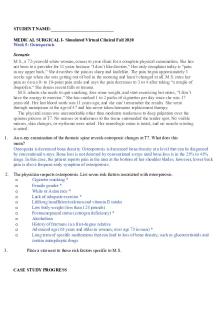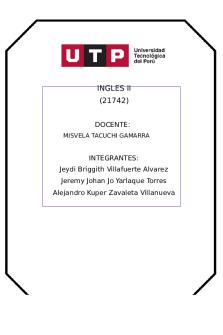Week 6 CAD-2 - casestudy PDF

| Title | Week 6 CAD-2 - casestudy |
|---|---|
| Author | chantel xiques |
| Course | Patient Centered Care: Adult/Elderly I |
| Institution | Barry University |
| Pages | 4 |
| File Size | 274 KB |
| File Type | |
| Total Downloads | 15 |
| Total Views | 147 |
Summary
casestudy...
Description
STUDENT NAME: Chantel Xiques Medical Surgical I- Simulated Virtual Clinical Fall 2020 Week 6: Coronary Artery Disease: Scenario You are a nurse at a freestanding cardiac prevention and rehabilitation center. Your new patient in risk-factor modification is B.J., a 37-year-old traveling salesman, who is married and has 3 children. During a recent evaluation for chest pain, he underwent a cardiac catheterization procedure that showed moderate single-vessel disease with a 50% stenosis in the mid right coronary artery (RCA). He was given a prescription for sublingual (SL) nitroglycerin (NTG), told how to use it, and referred to your cardiac rehabilitation program for sessions 3 days a week. B.J.’s wife comes along to help him with healthy lifestyle changes. You take the following nursing history: B.J.’s father died of sudden cardiac death at age 42, and his mother (still living) had a quadruple coronary artery bypass graft (CABG ¥4) at age 52; his hypertension (HTN) is controlled by taking metoprolol 25 mg q12h, which was also prescribed for his coronary disease, as well as by taking acetylsalicylic acid (ASA, aspirin) 325 mg/day PO; he has averaged 1.5 packs of cigarettes per day (PPD) for 20 years; an “occasional” beer (“a 6-pack every weekend with the football game”*); and a dietary history of fried and fast foods. His current weight is 235 pounds at 5¢8≤; he has a waist circumference of 48 inches. His vital signs (VS) are 138/88, 82, 18, and 98.4° F. *Note: Be alert to the fact that many individuals tend to underreport their alcohol and drug consumption. Clearly mark patient reports by using quotes to indicate subjective source of information. 1. Calculate B.J.’s smoking history in terms of pack-years. A Pack-year is calculated by taking the average number of packs smoked per day times the number of years smoked. In this example, it is 1.5 packs × 20 years = 30 pack-years.
2. List three nonmodifiable risk factors for coronary artery disease (CAD). Age, Family history, gender, and ethnic background. These are personal characteristics that cannot be altered or controlled.
3. List six modifiable risk factors for CAD. A few modifiable risk factors for CAD is smoking, obesity, physical inactivity, hypertension, diabetes mellitus, Hyperlipidemia, stress, excessive alcohol use. These are lifestyle choices that can be controlled or altered by the patient.
Underline each of the responses in questions 2 and 3 that represent B.J.’s personal CAD risk factors. I underlined Smoking, his Family history of CAD, he is obese, physical inactivity, gender (male), Hypertension, Hyperlipidemia and Stress. 4.
You would like to know more about B.J.’s hyperlipidemia. What four common laboratory values do you need to know? For those at risk for CAD, the fasting total cholesterol should be below 200 mg/dL, the HDL should be above 40 mg/dL, the LDL should be less than 100 mg/dL, and the triglycerides should be less than 150 mg/dL for men. 5.
CASE STUDY PROGRESS B.J. laughingly tells you he believes in the 5 all-American food groups: salt, sugar, fat, chocolate, and caffeine. 6. Identify health-related problems in this case description; the problem that is potentially life threatening should be listed first. High risk for sudden cardiac death (multiple risk factors such as family history, male); smoking, inactivity (sedentary lifestyle), obesity, stressful lifestyle, HTN, hyperlipidemia; and a high-fat, low fiber diet. 7. Of all his behaviors, which one is the most significant in promoting cardiac disease? His smoking is the riskiest. According to the American Heart Association, a smoker's risk of developing CAD is two to four times higher than that of nonsmokers. Those who smoke a pack of cigarettes per day have more than twice the risk of MI than nonsmokers.
8. What is the highest priority problem that you need to address with B.J.? Identify the teaching strategy you would use with him. Hint: What you think is the most important may not be what he considers the most important, or the one he is willing to work on. The most important problem is the one B.T. and his wife are willing to work on, the one they identify as most important. This helps their commitment to behavioral change. If they decide he needs to exercise. Inform him that cardiac rehabilitation will help him become more active and do it safely.
Try to get B.T. to work on smoking cessation. This is the biggest risk factor and affects not only him but also his wife and children's health (children exposed to cigarette smoke are more likely to have asthma and other diseases). Resources like The American Heart Association, the American Lung Association, and the American Cancer Society all have excellent literature and programs on smoking cessation. 9.What is the second problem you would work with B.J. to change? Identify an appropriate strategy to resolve the problem. Smoking: give them a list of smoking cessation classes, and explain how stopping smoking will reduce his risk for heart attack. He can consult his health care provider about pharmacologic aids for smoking cessation, such as nicotine patches or gum. Also Obesity: Give education on restaurant food, portion sizes, and calories, or give. In addition, teach him stress management techniques.
✽ Note: Whenever B.J. and his wife decide to attack dietary changes, try to get a referral to a registered dietitian (RD), who can work with them to develop strategies for long-term nutritional goals to decrease HTN and serum lipids. Many states require dietitians to be licensed the same way nurses are registered. Check to make certain that nutritional counseling for a person with specific disease states is not exceeding the nursing standard of practice for your state.
10. B.J.’s wife takes you aside and tells you, “I’m so worried for B. I grew up in a really dysfunctional family where there was a lot of violence. B. has been so good to the kids and me. I’m so worried I’ll lose him that I have nightmares about his heart stopping. I find myself suddenly awakening at night just to see if he’s breathing.” How are you going to respond? Assure her that you acknowledge that heart disease in a loved one can be a very frightening thing. Suggest that she practice stress-relaxation techniques with him. One could also ask whether she would like to talk to someone about her anxiety.
*Note: Nightmares about losing a loved one to heart disease are not rare, especially during the time of diagnosis or disease-related crisis. However, a background of childhood violence can have deep roots and often requires special help. Clearly this woman is in distress. Depending on her willingness at this time, it would be good for her to talk with a therapist. If she doesn’t think she needs it, try suggesting that it might be good for B.J. and the kids and that it would help her relax and be more responsive to them. At the appropriate point, it would be important for her to be able to share with her husband how she feels. From her description, this sleep disturbance is an unhealthy situation that should be addressed. If she refuses, keep an open relationship; it is important that she keep talking to someone about her fear.
Six weeks after you start working with B.J., he admits that he has been under a lot of stress. He rubs his chest and says, “It feels really heavy on my chest right now.” You feel his pulse and note that his skin is slightly diaphoretic, and that he is agitated and appears to be anxious. 11.What are you going to do to obtain additional information? Have B.T. stop any activity and sit or lie him down because you want to decrease the workload on his heart and decrease his body's need for oxygen. You will also check his vital signs and ask whether he has any SL NTG tablets with him. 12. B.J. continues to feel symptomatic. Now what are you going to do? According to current guidelines, if the chest pain or discomfort is not relieved in 5 minutes, after one dose of SL NTG, call 911 immediately. The patient can take one more tablet, while awaiting emergency care, and a third tablet 5 minutes later, but no more than three tablets total. If by then he does not feel relief, there may be an indication of an MI is occurring. Continue to monitor his vital signs, and consider checking a ECG (if available) to look for ischemic changes. Reassure him that you will stay with him....
Similar Free PDFs

Week 6 CAD-2 - casestudy
- 4 Pages

Week 5 Osteoporosis - casestudy
- 2 Pages

Redbull Casestudy
- 7 Pages

Week 6 Week 6 Week 6Week 6
- 2 Pages

Rakuten Casestudy
- 7 Pages

Week 6 ingles Week 6
- 2 Pages

Week 6 Assignment - Week 6
- 11 Pages

Casestudy - tutorial
- 4 Pages

Mc Donald Casestudy Analysis
- 7 Pages

Normal aldring- en casestudy
- 6 Pages

Lecture 6 - week 6
- 32 Pages

Week 6 Study Notes - week 6
- 6 Pages

Casestudy Kill Kapture
- 3 Pages

Brand Strategy Casestudy 2
- 2 Pages

Casestudy 76 - case study 24
- 6 Pages
Popular Institutions
- Tinajero National High School - Annex
- Politeknik Caltex Riau
- Yokohama City University
- SGT University
- University of Al-Qadisiyah
- Divine Word College of Vigan
- Techniek College Rotterdam
- Universidade de Santiago
- Universiti Teknologi MARA Cawangan Johor Kampus Pasir Gudang
- Poltekkes Kemenkes Yogyakarta
- Baguio City National High School
- Colegio san marcos
- preparatoria uno
- Centro de Bachillerato Tecnológico Industrial y de Servicios No. 107
- Dalian Maritime University
- Quang Trung Secondary School
- Colegio Tecnológico en Informática
- Corporación Regional de Educación Superior
- Grupo CEDVA
- Dar Al Uloom University
- Centro de Estudios Preuniversitarios de la Universidad Nacional de Ingeniería
- 上智大学
- Aakash International School, Nuna Majara
- San Felipe Neri Catholic School
- Kang Chiao International School - New Taipei City
- Misamis Occidental National High School
- Institución Educativa Escuela Normal Juan Ladrilleros
- Kolehiyo ng Pantukan
- Batanes State College
- Instituto Continental
- Sekolah Menengah Kejuruan Kesehatan Kaltara (Tarakan)
- Colegio de La Inmaculada Concepcion - Cebu
